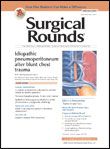Publication
Article
Automated Calculator Accurately Estimates Venous Thromboembolism Risk
Author(s):
Although the Caprini Thrombosis Risk Assessment Tool is widely used and well validated, many surgeons struggle to implement it appropriately and accurately when automated calculators are unavailable.

Although the Caprini Thrombosis Risk Assessment Tool is widely used and well validated, many surgeons struggle to implement it appropriately and accurately when automated calculators are unavailable.
Concerned about incorrect risk stratification in the intensive care unit (ICU), a team of surgeons from the University of Pennsylvania recently analyzed physicians’ aptitudes in completing a manual 2005 Caprini Risk Assessment Model (RAM) for venous thromboembolism (VTE). After the surgeons filled out the forms for all patients admitted to their high-volume, tertiary care surgical ICU between 2009 and 2012, the researchers compared their manual scores to their validated, computer-generated scores.
Across the study period, 3,338 consecutive surgical ICU admissions took place. In slightly more than half of those admissions, the computer-generated Caprini RAM scores were higher than the physician-reported scores, which indicated the patients’ VTE risk was higher than the staff realized. Additionally, inter-rater reliability between the scores was poor.
The overall inpatient VTE rate was 5.73%. When the surgeons underestimated risk scores by 2 points or more, patients were significantly more likely to develop VTE, and for each day the surgeon failed to prescribe chemoprophylaxis, the odds of a patient developing VTE increased.
Other factors that appeared to elevate the risk of inpatient VTE included higher admission APACHE score, personal history of VTE, recent pneumonia, and younger age.
According to the study authors, the repercussions of wrongly assuming that patients are at lower risk for VTE are far-reaching, as surgeons may prescribe chemoprophylaxis at too low a dose, frequency, or duration than what is actually needed to avoid VTE. In addition, surgeons may be less likely to encourage early ambulation, or they may allow patients to desist with sequential compression devices too early.
The researchers concluded that surgeons often experience difficulties in manually calculating 2005 Caprini RAM scores and, as a result, they fail to provide adequate VTE prophylaxis roughly 40% of the time. Since computer-calculated scores were shown to improve VTE risk stratification, the authors said they are proponents of incorporating the Caprini RAM into electronic medical records (EMRs) and daily practice.






